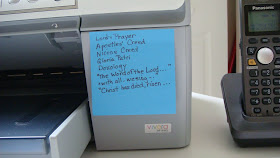There are some songs, prayers, and words
you just have to know in order to participate in a given congregation’s
worship. The list differs from congregation to
congregation, but includes such things as the Lord’s Prayer, the creeds, the
Doxology, the Gloria Patri, and congregational responses to scripture readings
and certain prayers. Many congregations try
to help visitors by listing page numbers in the hymnal where these words can be
found. But at some points in worship
things move so quickly that there is hardly time to use that help – especially if
you are an early reader. So we serve our
children well when we teach them these words so that they can sing, pray and
respond with the whole congregation.
Those who attend church
school classes may be learning some of these parts of worship there. But the very best opportunity to learn
anything is in the place you will use it and just before you will use it. So, a little on-the-spot worship education
can help the children and enrich worship for older worshipers.
How do you do this?
1.
Select one often
misunderstood word to translate for the children and explain what it means in
its given phrase. i.e. “the quick and the dead” in the Apostles’ Creed, “Hallowed”
in the Lord’s Prayer.
2.
Identify a line
that is connected to the day’s theme to discuss and illustrate with stories
during the sermon.
3.
Put one phrase
into your own words and identify situations in daily life when it can be prayed
or sung (as well as in congregational worship).
4.
Explain why you
say, sing or pray those words at the particular point in worship that you do, e.g.
why do you sing the Gloria Patri after hearing that God promises to forgive us.
5.
Discuss a phrase
then use it as the congregation’s response in a responsive reading that
enlarges on the meaning of the phrase, e.g. a prayer of confession in which the
congregation’s response is “forgive us our depts./trespasses/sins as we forgive….”
6.
Discuss a given
phrase or word then ask children to illustrate it. (Be sure you could illustrate it first!)
When do you do this?
1.
Invite the children
forward just before the part of worship you want to explore with them. Talk it through, practice it, then send them
back to their seats to do it with everyone else. (Yes, this could be a children’s time, but it
must be moveable. It is also possible to
do a children time aimed at younger children who then leave the sanctuary AND
gather the older children at the appropriate time to do this.)
2.
You can locate
this discussion in the “real” sermon. To
get the attention of children who may have tuned out, ask all worshipers to
open their hymn books to the given prayer or response. Talk about its meaning as related to the day’s
worship theme. (This not only gives the
children information about a given phrase, but also leads them to think sermons
might be for them too.)
3.
For big impact, interrupt
the piece you want to explore. “Pardon
me, but what did we just say/sing/pray?
What did we mean?” After talking
it through, repeat it together. For
example, at Thanksgiving, interrupt the Doxology to say, “Wait. Praise God from who all blessings flow? What is a blessing?” Define blessing and list some of your own. In informal congregations worshipers might
name some of theirs. Then sing the
Doxology again.
To get started
This is not something you
would want to do every Sunday, but occasionally as the worship theme calls for
it. So, make a list of what your children have to know to participate fully in
worship in your congregation. Post it
near your work space for a ready reminding reference as you plan worship. (Mine
is on a sticky note on my printer.)


No comments:
Post a Comment
Click on Comments below to leave a message or share an idea